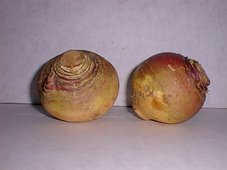
In today's Letter of the Day...
D.G. asks: "Do rutabagas contain sufficient gadolinium that their consumption might replace the costly injection of this strongly paramagnetic element prior to MRI imaging? And is it retained in fermented derivative products? There may be a new industry here."
This area of ARSI research is highly classified at present, but I can report that we will soon be applying to the Food and Drug Administration for approval as an MRI contrast agent for exactly the reasons you mention. The rutabaga contains only trace quantities of gadolinium. However, when properly refined, rutabaga extract is as ferromagnetic as gadolinium. The major advantage is price: gadolinium, which must be extracted at great cost from minerals such as monazite and bastnasite, currently sells for $485 per kilogram on the world market. The average price of rutabaga extract is currently less than $2 per kilogram. We will keep our fellow bloggers advised about new developments in this exciting area of rutastudies.
[Photo: Mt. Hood from ARSI's World Headquarters in Forest Grove, Oregon USA]





3 comments:
Thanks to all the publicity from this blog, the price of rutabaga has just soared to $2.01 per kilo. Back off, you guys, or you'll destroy your own market!
Is it true that extract of rutabaga can be used as an oral contraceptive? Please get back to me on this ASAP.
Rutabaga extract as an oral contraceptive? Unfortunately, someone has been leaking confidential inside information to you from ARSI labs. This promising product has been in development for several years, but without notable successes so far. In fact, the failure rate for the most recent clinical trial was 99.86%. On the advice of our counsel, ARSI will conduct future trials on fruit flies rather than humans. We consider this to be a temporary setback, so stay tuned for future developments. Meanwhile, I encourage you to look at alternatives right away.
Post a Comment